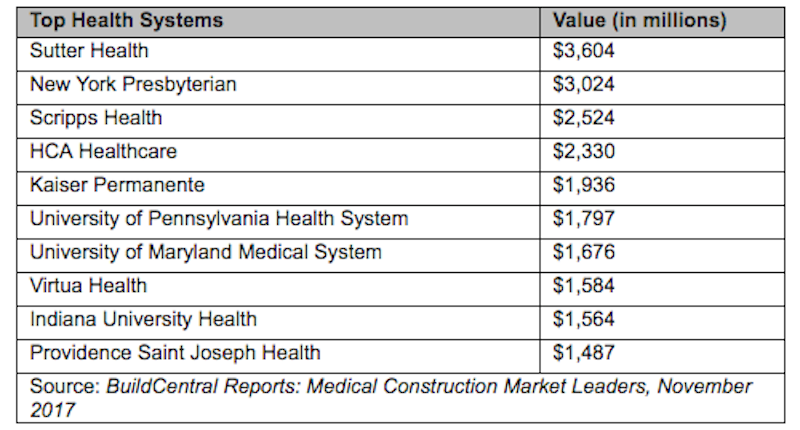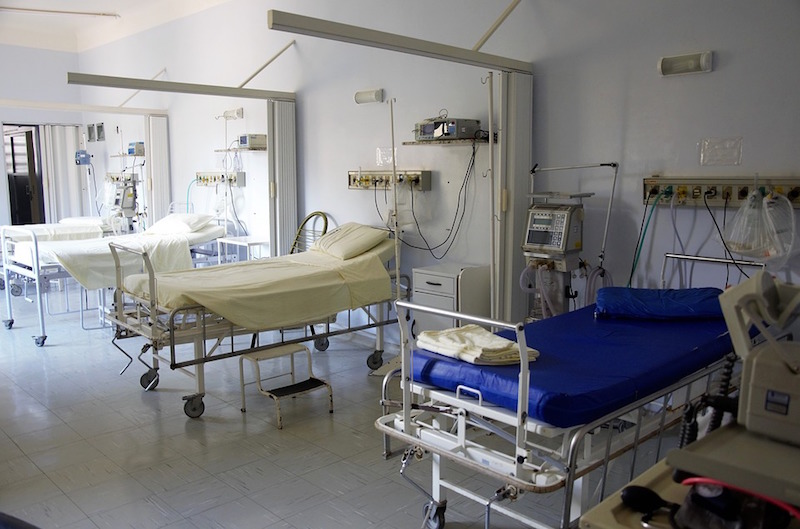Ten U.S. health systems account for more than $21.5 billion of current and upcoming construction, according to a report from BuildCentral.
“The healthcare sector continues to drive a major part of the construction market,” BuildCentral CEO Rick Kang said. “The top health systems have more than $12.3 billion in active projects plus another $9.2 billion in the planning stages.”
According to the report, three health systems each have active projects totaling at least $2 billion in value. Sutter Health, with its $2.1 billion California Pacific Medical Center Cathedral Hill Campus project in San Francisco, leads the list. New York Presbyterian Healthcare System has four major active projects in the New York City area. Scripps Health is currently replacing its Scripps Memorial Hospital in La Jolla, California to the tune of $2 billion.
Health systems with major planned projects include the University of Maryland Medical System with multiple projects that have a combined estimated value of $1.6 billion, Virtua Health with $1.5 billion, and Kaiser Permanente with $1.4 billion.
The top ten health systems ranked by combined active and planned construction value are:

The report is based on BuildCentral’s proprietary construction market research. The firm, headquartered in Chicago, compiles comprehensive reports on all major U.S. medical construction projects. The full report can be downloaded at https://www.buildcentral.com/
Related Stories
| Aug 11, 2010
Hospital Additions + Renovations: 14 Lessons from Expert Building Teams
Two additions to a community hospital in Ohio that will double its square footage. A 12-story addition on top of an existing 12-story tower at Houston's M.D. Anderson Cancer Center. A $54 million renovation and addition at the University of Virginia Medical Center. A 67-bed, $70 million addition/renovation to a community hospital that is only five years old.
| Aug 11, 2010
Research Facility Breaks the Mold
In the market for state-of-the-art biomedical research space in Boston's Longwood Medical Area? Good news: there are still two floors available in the Center for Life Science | Boston, a multi-tenant, speculative high-rise research building designed by Tsoi/Kobus & Associates, Boston, and developed by Lyme Properties, Hanover, N.
| Aug 11, 2010
3 Hospitals, 3 Building Teams, 1 Mission: Optimum Sustainability
It's big news in any city when a new billion-dollar hospital is announced. Imagine what it must be like to have not one, not two, but three such blockbusters in the works, each of them tracking LEED-NC Gold certification from the U.S. Green Building Council. That's the case in San Francisco, where three new billion-dollar-plus healthcare facilities are in various stages of design and constructi...
| Aug 11, 2010
Holyoke Health Center
The team behind the new Holyoke (Mass.) Health Center was aiming for more than the renovation of a single building—they were hoping to revive an entire community. Holyoke's central business district was built in the 19th century as part of a planned industrial town, but over the years it had fallen into disrepair.
| Aug 11, 2010
Right-Sizing Healthcare
Over the past 30 years or so, the healthcare industry has quietly super-sized its healthcare facilities. Since 1980, ORs have bulked up in size by 53%, acute-care patient rooms by 77%. The slow creep went unlabeled until recently, when consultant H. Scot Latimer applied the super-sizing moniker to hospitals, inpatient rooms, operating rooms, and other treatment and administrative spaces.
| Aug 11, 2010
Great Solutions: Healthcare
11. Operating Room-Integrated MRI will Help Neurosurgeons Get it Right the First Time A major limitation of traditional brain cancer surgery is the lack of scanning capability in the operating room. Neurosurgeons do their best to visually identify and remove the cancerous tissue, but only an MRI scan will confirm if the operation was a complete success or not.







